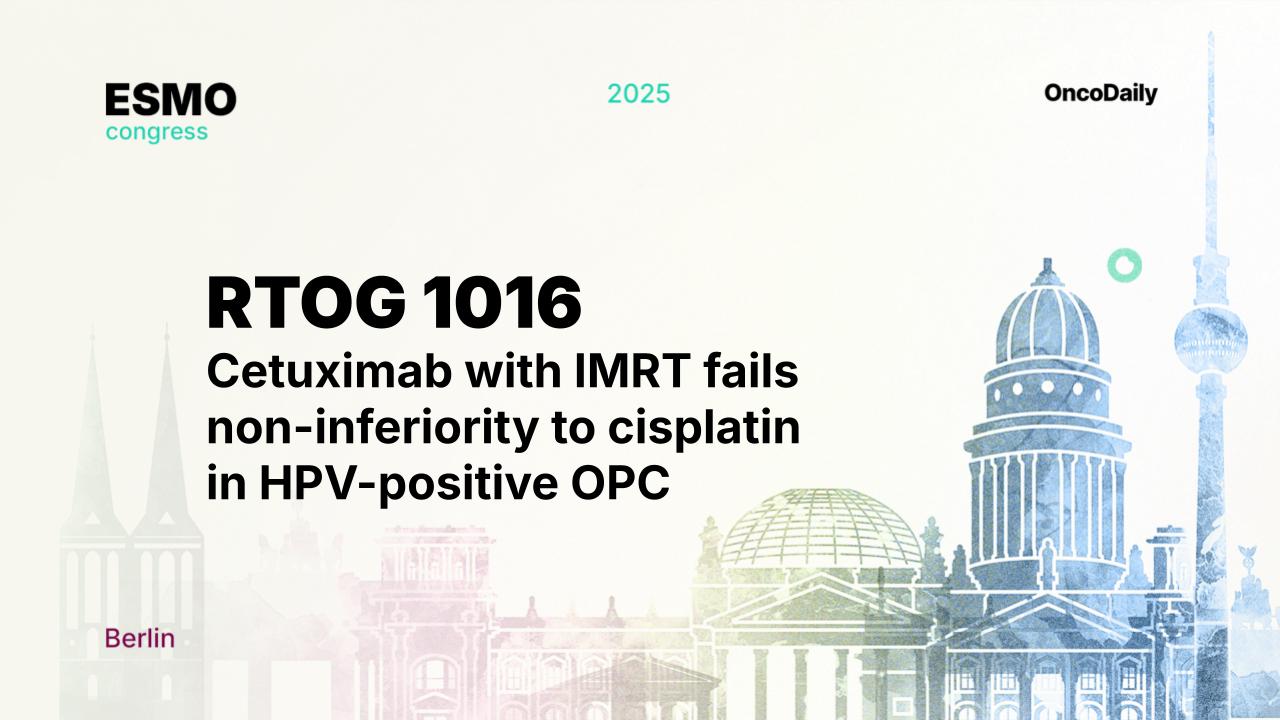At ESMO 2025, Jimmy Caudell presented RTOG 1016 during the Mini Oral session on Head & neck cancer, delivering a decade-long follow-up that revisits overall survival, progression-free survival, and late toxicities, and adds a detailed look at how recent and cumulative tobacco exposure shapes long-term outcomes in HPV-positive oropharyngeal cancer.
Background
RTOG 1016 was a noninferiority phase III trial testing whether replacing cisplatin with cetuximab during intensity-modulated radiotherapy (IMRT) could maintain overall survival (OS) for patients with HPV-positive oropharyngeal cancer (OPC). Early results at a 4.5-year median follow-up showed cetuximab failed noninferiority. Given the high baseline survival in this population, late disease-control outcomes, late adverse events, and lifestyle factors (notably tobacco exposure) are critical to understand over the long term.
Methods
Eligible patients (AJCC 7th T1-2N2-3 or T3-4N0-3, p16-positive OPC) were stratified by T stage, N stage, performance status, and smoking history (≤ or >10 pack-years); all completed a lifetime tobacco questionnaire at enrollment. Patients were randomized to cisplatin + IMRT (n=406) or cetuximab + IMRT (n=399). Key endpoints included OS, PFS, and acute/late toxicities (≤180 vs >180 days after IMRT). Hazard ratios (HRs) were estimated via Cox models.
Results
With a median follow-up of 10.2 years, cetuximab + IMRT did not meet noninferiority for OS (HR 1.18; one-sided 95% upper CI 1.46). Ten-year OS favored cisplatin numerically: 68.7% cisplatin vs 66.5% cetuximab. PFS remained significantly better with cisplatin (63.9% vs 59.1%; HR 1.30, 95% CI 1.03–1.63).
Late toxicity profile (selected any-grade unless specified):
- Hearing impairment: 33% cisplatin vs 17% cetuximab; tinnitus: 31% vs 13% (hearing-related toxicities more frequent with cisplatin).
- Late grade 3–4 AEs (overall): 25% cisplatin vs 20% cetuximab; grade 3–4 dysphagia: 6% vs 8%.
- Dysgeusia: 62% vs 59%; xerostomia: 86% vs 86%.
- Chronic kidney disease: 1% vs 0%; peripheral sensory neuropathy: 15% vs 8%.
Smoking exposure and survival (univariate):
- Current smoking at diagnosis associated with higher mortality (HR 2.00, 95% CI 1.42–2.80).
- Any smoking within the last 10 years (HR 2.11, 95% CI 1.64–2.71).
- >10 pack-years (HR 1.67, 95% CI 1.30–2.14).
- Hazard increased per pack-year (HR 1.008, 95% CI 1.004–1.012) and per year of use (HR 1.017, 95% CI 1.010–1.024).
Cohort smoking profile: 45% never/never-regular, 45% former, 10% current; among regular users, median 20 pack-years (IQR 8–37); 38% had >10 pack-years.
Conclusions
Long-term follow-up confirms that cetuximab with IMRT is not non-inferior to cisplatin with IMRT for OS in HPV-positive OPC and is associated with inferior PFS. While cisplatin carries higher rates of hearing-related toxicities and neuropathy, it remains the standard concurrent agent in this setting. The strong association between recent and cumulative tobacco exposure and worse survival underscores the importance of systematic smoking cessation and risk stratification in HPV-positive OPC care.
You can read the full abstract here.
